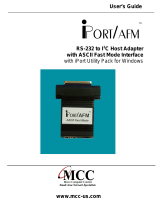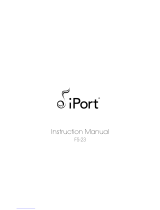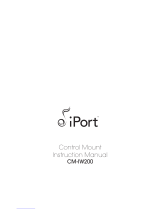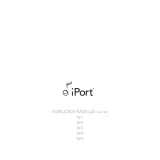Page is loading ...

MVI-ADMNET
'C' Programmable
'C' Programmable Application
Development Module with Ethernet
February 20, 2013
DEVELOPER'S GUIDE

Your Feedback Please
We always want you to feel that you made the right decision to use our products. If you have suggestions, comments,
compliments or complaints about our products, documentation, or support, please write or call us.
ProSoft Technology
5201 Truxtun Ave., 3rd Floor
Bakersfield, CA 93309
+1 (661) 716-5100
+1 (661) 716-5101 (Fax)
www.prosoft-technology.com
Copyright © 2013 ProSoft Technology, Inc., all rights reserved.
MVI-ADMNET Developer's Guide
February 20, 2013
ProSoft Technology
®
, ProLinx
®
, inRAx
®
, ProTalk
®
, and RadioLinx
®
are Registered Trademarks of ProSoft
Technology, Inc. All other brand or product names are or may be trademarks of, and are used to identify products
and services of, their respective owners.
In an effort to conserve paper, ProSoft Technology no longer includes printed manuals with our product shipments.
User Manuals, Datasheets, Sample Ladder Files, and Configuration Files are provided on the enclosed CD-ROM,
and are available at no charge from our web site: www.prosoft-technology.com.
Content Disclaimer
This documentation is not intended as a substitute for and is not to be used for determining suitability or reliability of
these products for specific user applications. It is the duty of any such user or integrator to perform the appropriate
and complete risk analysis, evaluation and testing of the products with respect to the relevant specific application or
use thereof. Neither ProSoft Technology nor any of its affiliates or subsidiaries shall be responsible or liable for
misuse of the information contained herein. Information in this document including illustrations, specifications and
dimensions may contain technical inaccuracies or typographical errors. ProSoft Technology makes no warranty or
representation as to its accuracy and assumes no liability for and reserves the right to correct such inaccuracies or
errors at any time without notice. If you have any suggestions for improvements or amendments or have found errors
in this publication, please notify us.
No part of this document may be reproduced in any form or by any means, electronic or mechanical, including
photocopying, without express written permission of ProSoft Technology. All pertinent state, regional, and local safety
regulations must be observed when installing and using this product. For reasons of safety and to help ensure
compliance with documented system data, only the manufacturer should perform repairs to components. When
devices are used for applications with technical safety requirements, the relevant instructions must be followed.
Failure to use ProSoft Technology software or approved software with our hardware products may result in injury,
harm, or improper operating results. Failure to observe this information can result in injury or equipment damage.
© 2013 ProSoft Technology. All rights reserved.
Printed documentation is available for purchase. Contact ProSoft Technology for pricing and availability.
North America: +1.661.716.5100
Asia Pacific: +603.7724.2080
Europe, Middle East, Africa: +33 (0) 5.3436.87.20

Latin America: +1. 281.298.9109
Important Installation Instructions
Power, Input, and Output (I/O) wiring must be in accordance with Class I, Division 2 wiring methods, Article 501-4 (b)
of the National Electrical Code, NFPA 70 for installation in the U.S., or as specified in Section 18-1J2 of the Canadian
Electrical Code for installations in Canada, and in accordance with the authority having jurisdiction. The following
warnings must be heeded:
A WARNING - EXPLOSION HAZARD - SUBSTITUTION OF COMPONENTS MAY IMPAIR SUITABILITY FOR
CLASS I, DIV. 2;
B WARNING - EXPLOSION HAZARD - WHEN IN HAZARDOUS LOCATIONS, TURN OFF POWER BEFORE
REPLACING OR WIRING MODULES
C WARNING - EXPLOSION HAZARD - DO NOT DISCONNECT EQUIPMENT UNLESS POWER HAS BEEN
SWITCHED OFF OR THE AREA IS KNOWN TO BE NON-HAZARDOUS.
D THIS DEVICE SHALL BE POWERED BY CLASS 2 OUTPUTS ONLY.
MVI (Multi Vendor Interface) Modules
WARNING - EXPLOSION HAZARD - DO NOT DISCONNECT EQUIPMENT UNLESS POWER HAS BEEN
SWITCHED OFF OR THE AREA IS KNOWN TO BE NON-HAZARDOUS.
AVERTISSEMENT - RISQUE D'EXPLOSION - AVANT DE DÉCONNECTER L'ÉQUIPEMENT, COUPER LE
COURANT OU S'ASSURER QUE L'EMPLACEMENT EST DÉSIGNÉ NON DANGEREUX.
Warnings
North America Warnings
A Warning - Explosion Hazard - Substitution of components may impair suitability for Class I, Division 2.
B Warning - Explosion Hazard - When in Hazardous Locations, turn off power before replacing or rewiring
modules.
Warning - Explosion Hazard - Do not disconnect equipment unless power has been switched off or the area is
known to be nonhazardous.
C Suitable for use in Class I, division 2 Groups A, B, C and D Hazardous Locations or Non-Hazardous Locations.
ATEX Warnings and Conditions of Safe Usage:
Power, Input, and Output (I/O) wiring must be in accordance with the authority having jurisdiction
A Warning - Explosion Hazard - When in hazardous locations, turn off power before replacing or wiring modules.
B Warning - Explosion Hazard - Do not disconnect equipment unless power has been switched off or the area is
known to be non-hazardous.
C These products are intended to be mounted in an IP54 enclosure. The devices shall provide external means to
prevent the rated voltage being exceeded by transient disturbances of more than 40%. This device must be used
only with ATEX certified backplanes.
D DO NOT OPEN WHEN ENERGIZED.
Electrical Ratings
Backplane Current Load: 800 mA @ 5 V DC; 3mA @ 24V DC
Operating Temperature: 0 to 60°C (32 to 140°F)
Storage Temperature: -40 to 85°C (-40 to 185°F)
Shock: 30g Operational; 50g non-operational; Vibration: 5 g from 10 to 150 Hz
Relative Humidity 5% to 95% (non-condensing)
All phase conductor sizes must be at least 1.3 mm(squared) and all earth ground conductors must be at least
4mm(squared).

Markings - MVI56, MVI69, PTQ
CE
EMC-EN61326-1:2006; EN6100-6-4:2007
CSA/cUL
C22.2 No. 213-1987
CSA CB Certified
IEC61010
ATEX
EN60079-0 Category 3, Zone 2
EN60079-15
243333
ME06
Markings - MVI46, MVI71
ANSI / ISA
ISA 12.12.01 Class I Division 2, GPs A, B, C, D
CSA/cUL
C22.2 No. 213-1987
CSA CB Certified
IEC61010
ATEX
EN60079-0 Category 3, Zone 2
EN60079-15
243333
Warning: This module is not hot-swappable! Always remove power from the rack before inserting or removing this
module, or damage may result to the module, the processor, or other connected devices.
Battery Life Advisory
The MVI46, MVI56, MVI56E, MVI69, and MVI71 modules use a rechargeable Lithium Vanadium Pentoxide battery to
backup the real-time clock and CMOS. The battery should last for the life of the module. The module must be
powered for approximately twenty hours before the battery becomes fully charged. After it is fully charged, the battery
provides backup power for the CMOS setup and the real-time clock for approximately 21 days. When the battery is
fully discharged, the module will revert to the default BIOS and clock settings.
Note: The battery is not user replaceable.

MVI-ADMNET ♦ 'C' Programmable Contents
'C' Programmable Application Development Module with Ethernet Developer's Guide
ProSoft Technology, Inc. Page 5 of 122
February 20, 2013
Contents
Your Feedback Please ........................................................................................................................ 2
Content Disclaimer .............................................................................................................................. 2
Important Installation Instructions ....................................................................................................... 3
MVI (Multi Vendor Interface) Modules ................................................................................................ 3
Warnings ............................................................................................................................................. 3
Battery Life Advisory ........................................................................................................................... 4
1 Introduction 9
1.1 Operating System .................................................................................................... 10
2 Preparing the MVI-ADMNET Module 11
2.1 Package Contents ................................................................................................... 12
2.2 Jumper Locations and Settings ............................................................................... 13
2.2.1 Setup Jumper .......................................................................................................... 13
2.2.2 Port 1 and Port 2 Jumpers ...................................................................................... 13
2.3 Connections ............................................................................................................ 14
2.3.1 MVI-ADMNET Communication Ports ...................................................................... 14
3 Setting Up Your Development Environment 15
3.1 Setting Up Your Compiler........................................................................................ 16
3.1.1 Configuring Digital Mars C++ 8.49 .......................................................................... 16
3.1.2 Configuring Borland C++5.02 .................................................................................. 25
3.2 ROM Disk Configuration.......................................................................................... 33
3.2.1 CONFIG.SYS File ................................................................................................... 33
3.2.2 Command Interpreter .............................................................................................. 35
3.2.3 Sample ROM Disk Image ........................................................................................ 35
3.3 Creating a ROM Disk Image ................................................................................... 37
3.3.1 WINIMAGE: Windows Disk Image Builder .............................................................. 37
3.4 Downloading a ROM Disk Image ............................................................................ 39
3.4.1 MVIUPDAT .............................................................................................................. 39
3.5 MVI System BIOS Setup ......................................................................................... 41
3.6 Transferring Files to and from the Module with HyperTerminal .............................. 43
3.6.1 Required Software ................................................................................................... 43
3.6.2 Connecting to the Module ....................................................................................... 44
3.6.3 Enabling the Console .............................................................................................. 45
3.6.4 Installing RY.exe and SY.exe .................................................................................. 49
3.6.5 Downloading Files From a PC to the ADM Module ................................................ 49
3.6.6 Uploading files from the ADM module to a PC........................................................ 50
3.7 Installing and Configuring the Module ..................................................................... 52
3.7.1 Using Side-Connect (Requires Side-Connect Adapter) (MVI71) ............................ 52
4 Understanding the MVI-ADMNET API 55
4.1 API Libraries ............................................................................................................ 56
4.1.1 Calling Convention .................................................................................................. 56

Contents MVI-ADMNET ♦ 'C' Programmable
Developer's Guide 'C' Programmable Application Development Module with Ethernet
Page 6 of 122 ProSoft Technology, Inc.
February 20, 2013
4.1.2 Header File ............................................................................................................. 56
4.1.3 Sample Code .......................................................................................................... 56
4.1.4 Multi-threading Considerations ............................................................................... 57
4.2 Development Tools ................................................................................................. 58
4.3 Theory of Operation ................................................................................................ 59
4.3.1 ADM API ................................................................................................................. 59
4.3.2 ADMNET API Architecture ...................................................................................... 59
4.4 ADM API Files......................................................................................................... 60
4.4.1 ADM Interface Structure ......................................................................................... 60
5 Application Development Function Library - ADMNET API 63
5.1 ADMNET API Functions ......................................................................................... 64
5.2 ADMNET API Initialize Functions ........................................................................... 65
ADM_init_socket ......................................................................................................................... 65
ADM_open_sk ............................................................................................................................. 66
ADM_init_UDP_buffer ................................................................................................................. 67
5.3 ADMNET API Release Socket Functions ............................................................... 68
ADM_release_sockets ................................................................................................................ 68
ADM_close_sk ............................................................................................................................ 69
5.4 ADMNET API Send Socket Functions .................................................................... 70
ADM_send_socket ...................................................................................................................... 70
ADM_send_sk ............................................................................................................................. 71
5.5 ADMNET API Receive Socket Functions ............................................................... 72
ADM_receive_socket .................................................................................................................. 72
ADM_receive_sk ......................................................................................................................... 73
ADM_receive_buffered_UDP_sk ................................................................................................ 74
5.6 ADMNET API Miscellaneous Functions ................................................................. 75
ADM_NET_GetVersionInfo ......................................................................................................... 75
ADM_is_sk_open ........................................................................................................................ 76
6 WATTCP API Functions 77
6.1 WATTCP API Functions ......................................................................................... 78
6.2 ADMNET API Initialize Functions ........................................................................... 80
sock_init ....................................................................................................................................... 80
6.3 ADMNET API System Functionality ....................................................................... 81
tcp_tick ........................................................................................................................................ 81
tcp_open ...................................................................................................................................... 82
tcp_open_fast .............................................................................................................................. 83
udp_open..................................................................................................................................... 84
udp_open_fast ............................................................................................................................. 85
resolve ......................................................................................................................................... 86
sock_mode .................................................................................................................................. 87
sock_established ......................................................................................................................... 88
ip_timer_init ................................................................................................................................. 89
ip_timer_expired .......................................................................................................................... 90
set_timeout .................................................................................................................................. 91
chk_timeout ................................................................................................................................. 92
sockerr ......................................................................................................................................... 93
sockstate ..................................................................................................................................... 94
gethostid ...................................................................................................................................... 95
6.4 ADMNET API Release Socket Functions ............................................................... 96

MVI-ADMNET ♦ 'C' Programmable Contents
'C' Programmable Application Development Module with Ethernet Developer's Guide
ProSoft Technology, Inc. Page 7 of 122
February 20, 2013
sock_exit ...................................................................................................................................... 96
sock_abort ................................................................................................................................... 97
sock_close ................................................................................................................................... 98
6.5 ADMNET API Send Socket Functions .................................................................... 99
sock_write .................................................................................................................................... 99
sock_fastwrite ............................................................................................................................ 100
sock_flush .................................................................................................................................. 101
sock_flushnext ........................................................................................................................... 102
sock_puts ................................................................................................................................... 103
sock_putc ................................................................................................................................... 104
6.6 ADMNET API Receive Socket Functions .............................................................. 105
sock_read .................................................................................................................................. 105
sock_fastread ............................................................................................................................. 106
tcp_listen .................................................................................................................................... 107
sock_gets ................................................................................................................................... 108
sock_getc ................................................................................................................................... 109
sock_dataready .......................................................................................................................... 110
rip ............................................................................................................................................... 111
inet_ntoa .................................................................................................................................... 112
inet_addr .................................................................................................................................... 113
7 Support, Service & Warranty 115
7.1 Contacting Technical Support ............................................................................... 115
7.2 Warranty Information ............................................................................................. 116
Glossary of Terms 117
Index 121

Contents MVI-ADMNET ♦ 'C' Programmable
Developer's Guide 'C' Programmable Application Development Module with Ethernet
Page 8 of 122 ProSoft Technology, Inc.
February 20, 2013

MVI-ADMNET ♦ 'C' Programmable Introduction
'C' Programmable Application Development Module with Ethernet Developer's Guide
ProSoft Technology, Inc. Page 9 of 122
February 20, 2013
1 Introduction
In This Chapter
Operating System .................................................................................. 10
This document provides information needed to develop application programs for
the MVI ADM Ethernet Serial Communication Module. The MVI suite of modules
is designed to allow devices with a serial and Ethernet port to be accessed by a
PLC. The modules and their corresponding platforms are as follows:
MVI46: 1746 (SLC)
MVI56: 1756 (ControlLogix)
MVI69: 1769 (CompactLogix)
MVI71: 1771 (PLC)
The modules are programmable to accommodate devices with unique Serial-
Ethernet protocols.
This document includes information about the available ethernet communication
software API libraries, programming information, and example code. For tools,
module configuration, serial communication software API, serial communication
programming information, and example code for both the module and the PLC,
refer to MVI ADM Developer’s Guide.
This document assumes the reader is familiar with software development in the
16-bit DOS environment using the 'C' programming language. This document
also assumes that the reader is familiar with Rockwell Automation programmable
controllers and the PLC platform.

Introduction MVI-ADMNET ♦ 'C' Programmable
Developer's Guide 'C' Programmable Application Development Module with Ethernet
Page 10 of 122 ProSoft Technology, Inc.
February 20, 2013
1.1 Operating System
The MVI module includes General Software Embedded DOS 6-XL. This
operating system provides DOS compatibility along with real-time multitasking
functionality. The operating system is stored in Flash ROM and is loaded by the
BIOS when the module boots.
DOS compatibility allows user applications to be developed using standard DOS
tools, such as Digital Mars and Borland compilers. User programs may be
executed automatically by loading them from either the CONFIG.SYS file or an
AUTOEXEC.BAT file. In addition to MVI-ADMNET, ADMTCP.CFG is required to
assign an IP address to the module. Users can store the ADMTCP.CFG file
directly to a Compact Flash.
The format of the ADMTCP.CFG is as follows:
# ProSoft Technology
# Default private class 3 address
my_ip=192.168.0.148
# Default class 3 network mask
netmask=255.255.255.0
# name server 1 up to 9 may be included
# nameserver=xxx.xxx.xxx.xxx
# name server 2
# nameserver=xxx.xxx.xxx.xxx
# The gateway I wish to use
gateway=192.168.0.1
# some networks (class 2) require all three parameters
# gateway,network,subnetmask
# gateway 192.168.0.1,192.168.0.0,255.255.255.0
# The name of my network
# domainslist="mynetwork.name"
Note: DOS programs that try to access the video or keyboard hardware directly will not function
correctly on the MVI module. Only programs that use the standard DOS and BIOS functions to
perform console I/O are compatible.

MVI-ADMNET ♦ 'C' Programmable Preparing the MVI-ADMNET Module
'C' Programmable Application Development Module with Ethernet Developer's Guide
ProSoft Technology, Inc. Page 11 of 122
February 20, 2013
2 Preparing the MVI-ADMNET Module
In This Chapter
Package Contents ................................................................................. 12
Jumper Locations and Settings ............................................................. 13
Connections .......................................................................................... 14

Preparing the MVI-ADMNET Module MVI-ADMNET ♦ 'C' Programmable
Developer's Guide 'C' Programmable Application Development Module with Ethernet
Page 12 of 122 ProSoft Technology, Inc.
February 20, 2013
2.1 Package Contents
Your MVI-ADMNET package includes:
MVI-ADMNET Module
ProSoft Technology Solutions CD-ROM (includes all documentation, sample
code, and sample ladder logic).
Null Modem Cable
Mini-DIN to DB-9 Cable

MVI-ADMNET ♦ 'C' Programmable Preparing the MVI-ADMNET Module
'C' Programmable Application Development Module with Ethernet Developer's Guide
ProSoft Technology, Inc. Page 13 of 122
February 20, 2013
2.2 Jumper Locations and Settings
Each module has three jumpers:
Setup
Port 1
Port 2
2.2.1 Setup Jumper
The Setup jumper, located at the bottom of the module, should have the two pins
jumpered when programming the module. Once programmed, the jumper should
be removed.
2.2.2 Port 1 and Port 2 Jumpers
These jumpers, located at the bottom of the module, configure the port settings
to RS-232, RS-422, or RS-485. By default, the jumpers for both ports are set to
RS-232. These jumpers must be set properly before using the module.

Preparing the MVI-ADMNET Module MVI-ADMNET ♦ 'C' Programmable
Developer's Guide 'C' Programmable Application Development Module with Ethernet
Page 14 of 122 ProSoft Technology, Inc.
February 20, 2013
2.3 Connections
2.3.1 MVI-ADMNET Communication Ports
The MVI-ADMNET module has three physical connectors: two application ports
and one debugging port, with an RJ45 plug and Ethernet port located on the front
of the module.

MVI-ADMNET ♦ 'C' Programmable Setting Up Your Development Environment
'C' Programmable Application Development Module with Ethernet Developer's Guide
ProSoft Technology, Inc. Page 15 of 122
February 20, 2013
3 Setting Up Your Development Environment
In This Chapter
Setting Up Your Compiler ...................................................................... 16
ROM Disk Configuration ........................................................................ 33
Creating a ROM Disk Image .................................................................. 37
Downloading a ROM Disk Image .......................................................... 39
MVI System BIOS Setup ....................................................................... 41
Transferring Files to and from the Module with HyperTerminal ............. 43
Installing and Configuring the Module ................................................... 52

Setting Up Your Development Environment MVI-ADMNET ♦ 'C' Programmable
Developer's Guide 'C' Programmable Application Development Module with Ethernet
Page 16 of 122 ProSoft Technology, Inc.
February 20, 2013
3.1 Setting Up Your Compiler
There are some important compiler settings that must be set in order to
successfully compile an application for the MVI platform. The following topics
describe the setup procedures for each of the supported compilers.
3.1.1 Configuring Digital Mars C++ 8.49
The following procedure allows you to successfully build the sample ADM code
supplied by ProSoft Technology using Digital Mars C++ 8.49. After verifying that
the sample code can be successfully compiled and built, you can modify the
sample code to work with your application.
Note: This procedure assumes that you have successfully installed Digital Mars C++ 8.49 on your
workstation.
Downloading the Sample Program
The sample code files are located in the ADM_TOOL_MVI.ZIP file. This zip file is
available from the CD-ROM shipped with your system or from the
www.prosoft-technology.com web site. When you unzip the file, you will find the
sample code files in \ADM_TOOL_MVI\SAMPLES\.
Important: The sample code and libraries in the 1756-MVI-Samples folder are not compatible with,
and are not supported for, the Digital Mars compiler.
Building an Existing Digital Mars C++ 8.49 ADM Project
1 Start Digital Mars C++ 8.49, and then click Project Open from the Main
Menu.
2 From the Folders field, navigate to the folder that contains the project
(C:\ADM_TOOL_MVI\SAMPLES\…).
3 In the File Name field, click on the project name (56adm-si.prj).

MVI-ADMNET ♦ 'C' Programmable Setting Up Your Development Environment
'C' Programmable Application Development Module with Ethernet Developer's Guide
ProSoft Technology, Inc. Page 17 of 122
February 20, 2013
4 Click OK. The Project window appears:
5 Click Project Rebuild All from the Main Menu to create the .exe file. The
status of the build will appear in the Output window:
Porting Notes: The Digital Mars compiler classifies duplicate library names as Level 1 Errors
rather than warnings. These errors will manifest themselves as "Previous Definition Different:
function name". Level 1 errors are non-fatal and the executable will build and run. The architecture
of the ADM libraries will cause two or more of these errors to appear when the executable is built.
This is a normal occurrence. If you are building existing code written for a different compiler you
may have to replace calls to run-time functions with the Digital Mars equivalent. Refer to the Digital
Mars documentation on the Run-time Library for the functions available.
6 The executable file will be located in the directory listed in the Compiler
Output Directory field. If it is blank then the executable file will be located in
the same folder as the project file. The Project Settings window can be
accessed by clicking Project Settings from the Main Menu.

Setting Up Your Development Environment MVI-ADMNET ♦ 'C' Programmable
Developer's Guide 'C' Programmable Application Development Module with Ethernet
Page 18 of 122 ProSoft Technology, Inc.
February 20, 2013
Creating a New Digital Mars C++ 8.49 ADM Project
1 Start Digital Mars C++ 8.49, and then click Project New from the Main
Menu.
2 Select the path and type in the Project Name.
3 Click Next.
4 In the Platform field, choose DOS.
5 In the Project Settings choose Release if you do not want debug information
included in your build.

MVI-ADMNET ♦ 'C' Programmable Setting Up Your Development Environment
'C' Programmable Application Development Module with Ethernet Developer's Guide
ProSoft Technology, Inc. Page 19 of 122
February 20, 2013
6 Click Next.
7 Select the first source file necessary for the project.
8 Click Add.
9 Repeat this step for all source files needed for the project.
10 Repeat the same procedure for all library files (.lib) needed for the project.
11 Choose Libraries (*.lib) from the List Files of Type field to view all library files:

Setting Up Your Development Environment MVI-ADMNET ♦ 'C' Programmable
Developer's Guide 'C' Programmable Application Development Module with Ethernet
Page 20 of 122 ProSoft Technology, Inc.
February 20, 2013
12 Click Next.
13 Add any defines or include directories desired.
14 Click Finish.
15 The Project window should now contain all the necessary source and library
files as shown in the following window:
/













